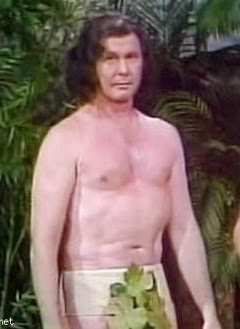It was dreadful. It brought back terrible memories of childhood, when those "colorful figures from our nation's past" were pounded into my brain through incessant classroom assignments and Wonderful World of Disney episodes.
Pecos Bill rode a mountain lion instead of a horse, used a snake for a lasso, and ate dynamite for a snack.
Davy Crockett was once swallowed by a bear, so he turned it inside out and escaped.
Paul Bunyan carved out the Grand Canyon by dragging his axe in the dirt.
Mike Fink (left) was half horse, half alligator, and half snapping turtle.
Who cared? I much preferred Tarzan, Batman and Robin, and the Man from U.N.C.L.E. For that matter, Li'l Abner and Alley Oop from the comics page.
For that matter, Donald Duck and Uncle Scrooge.
And some of the tales weren't even very tall:
Casey Jones ran a railroad engine fast.

John Henry...well, he drilled a million holes in rocks, and then died.
Johnny Appleseed...um, well, he walked around planting trees.
But, on the bright side, they weren't given many heterosexual exploits.
Pecos Bill had a girlfriend, and I just discovered that Paul Bunyan had one, but she doesn't appear in any stories that I recall.
The other Big Men were portrayed without Big Women.
And there was a a lot of beefcake. Big Men were by definition as muscular as Superman.
You could ask your parents for a Davy Crockett action figure, and then strip him out of his clothes.
John Henry was portrayed as a hard-iron bodybuilder, as in this 8-foot tall statue in Talcott, West Virginia.
And Paul Bunyan? Just think about the possibilities. If he is 30 feet tall, then he must have a three-foot long....
See also: G.I. Joe and Ken; Roadside Beefcake









































